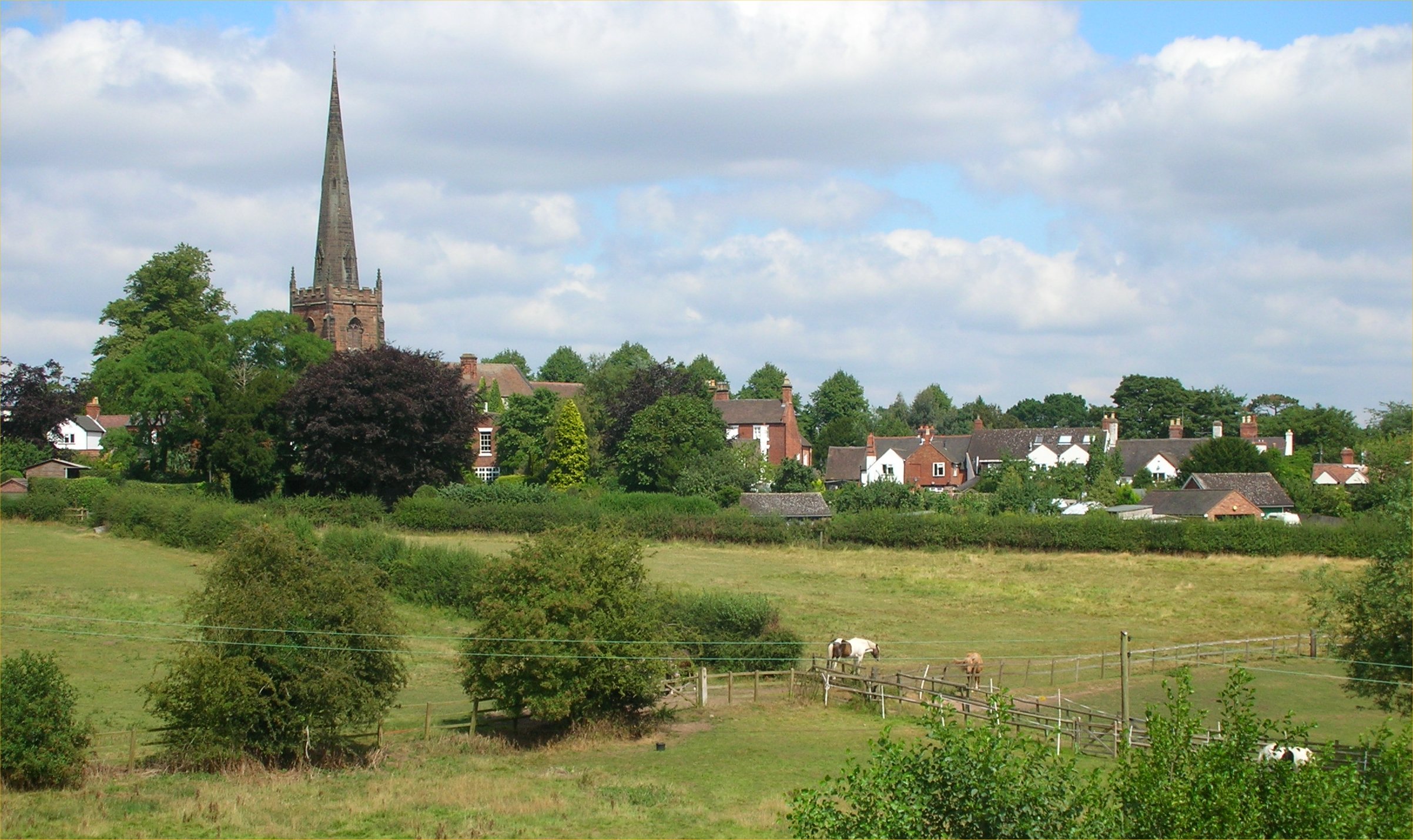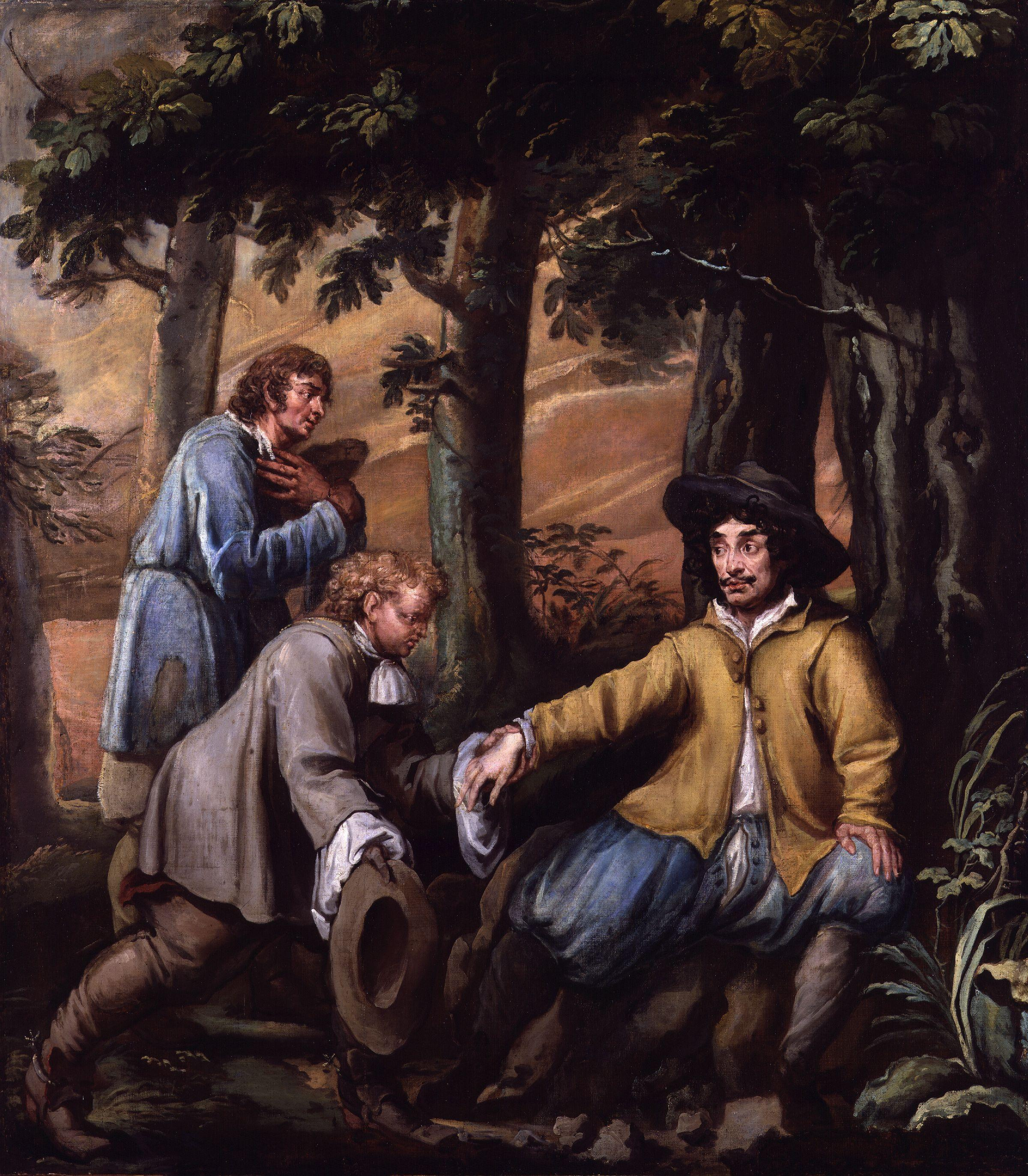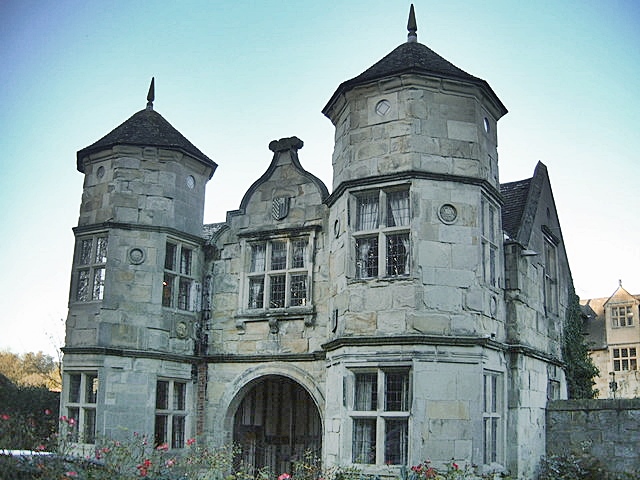|
Royal Oak
The Royal Oak is the English oak tree within which the future King Charles II of England hid to escape the Roundheads following the Battle of Worcester in 1651. The tree was in Boscobel Wood, which was part of the park of Boscobel House. Charles told Samuel Pepys in 1680 that while he was hiding in the tree, a Parliamentarian soldier passed directly below it. The story was popular after the Restoration, and is remembered every year in the English traditions of Royal Oak Day. Numerous large slipware dishes (known as 'chargers') depicting the Boscobel Oak were made by the Staffordshire potter Thomas Toft. The oak tree is shown being supported by the Lion and Unicorn, with the king's face peeping from the branches. History After the defeat of Charles' Royalist army at the hands of Oliver Cromwell's New Model Army, the King fled with Lord Derby, Lord Wilmot and other royalists, seeking shelter at the safe houses of White Ladies Priory and Boscobel House. Initially, Ch ... [...More Info...] [...Related Items...] OR: [Wikipedia] [Google] [Baidu] |
Quercus Robur
''Quercus robur'', commonly known as common oak, pedunculate oak, European oak or English oak, is a species of flowering plant in the beech and oak family, Fagaceae. It is a large tree, native to most of Europe west of the Caucasus. It is widely cultivated in temperate regions elsewhere and has escaped into the wild in scattered parts of China and North America. Description ''Quercus robur'' is a large deciduous tree, with circumference of grand oaks from to an exceptional . The Majesty Oak with a circumference of is the thickest tree in Great Britain. The Brureika (Bridal Oak) in Norway with a circumference of (2018) and the Kaive Oak in Latvia with a circumference of are among the thickest trees in Northern Europe. The largest historical oak was known as the Imperial Oak from Bosnia and Herzegovina. This specimen was recorded at 17.5 m in circumference at breast height and estimated at over 150 m³ in total volume. It collapsed in 1998. The species has lobed and nea ... [...More Info...] [...Related Items...] OR: [Wikipedia] [Google] [Baidu] |
Jane Lane, Lady Fisher
Jane Lane (c. 1626 – 9 September 1689) played a heroic role in the escape of Charles II in 1651 after the Battle of Worcester. She rode with Charles, disguised as her servant, from Staffordshire to Somerset. Origins Jane was the daughter of Thomas Lane and Anne Bagot of the parish of Bentley and Hyde (near Walsall). Her parents had married at Blithfield, Staffordshire, in 1608. Their son, John, was born on 8 April 1609, the first of what were to be four sons and five daughters. There are several early christening dates for a Jane Lane in the International Genealogical Index which have been estimated by contributors, most probably based on a spurious date for her marriage. However she was known as 'Jane Lane' in 1651 and so was unmarried at that date. Known birth (and other) dates for Jane Lane's siblings are: * John (8 April 1609 – 31 August 1667) a colonel in the Royalist army and, after the Restoration, MP for Lichfield * Walter Lane—born May 1611 * William Lane—b ... [...More Info...] [...Related Items...] OR: [Wikipedia] [Google] [Baidu] |
Wolverhampton
Wolverhampton () is a city, metropolitan borough and administrative centre in the West Midlands, England. The population size has increased by 5.7%, from around 249,500 in 2011 to 263,700 in 2021. People from the city are called "Wulfrunians". Historically part of Staffordshire, the city grew initially as a market town specialising in the wool trade. In the Industrial Revolution, it became a major centre for coal mining, steel production, lock making, and the manufacture of cars and motorcycles. The economy of the city is still based on engineering, including a large aerospace industry, as well as the service sector. Toponym The city is named after Wulfrun, who founded the town in 985, from the Anglo-Saxon ''Wulfrūnehēantūn'' ("Wulfrūn's high or principal enclosure or farm"). Before the Norman Conquest, the area's name appears only as variants of ''Heantune'' or ''Hamtun'', the prefix ''Wulfrun'' or similar appearing in 1070 and thereafter. Alternatively, the city may h ... [...More Info...] [...Related Items...] OR: [Wikipedia] [Google] [Baidu] |
Moseley Old Hall
Moseley Old Hall is located in Fordhouses, north of Wolverhampton in the United Kingdom. It is famous as one of the resting places of Charles II of England during his escape to France following defeat at the Battle of Worcester in 1651. It is now a National Trust property. Hall The Hall is located in Staffordshire. Construction and early history The estate was owned by a Cordsall family until it was purchased by Henry Pitt of Bushby, one of the Merchants of the Staple, in 1583. He constructed the Hall around 1600 (the exact date is unknown). Originally known as 'Mr Pitt's new Hall at Moseley', it was a half-timbered building located in remote woodland. When Henry died in 1602, the Hall was inherited by Alice Pitt, his daughter, who later married Thomas Whitgreave from Bridgeford, Staffordshire, whose family came from the nearby Whitgreave. Role in Charles II's escape After the final battle of the English Civil War, the Battle of Worcester on 3 September 1651, King ... [...More Info...] [...Related Items...] OR: [Wikipedia] [Google] [Baidu] |
Priest Hole
A priest hole is a hiding place for a priest built into many of the principal Catholic houses of England, Wales and Ireland during the period when Catholics were persecuted by law. When Queen Elizabeth I came to the throne in 1558, there were several Catholic plots designed to remove her and severe measures were taken against Catholic priests. Many great houses had a priest hole built so that the presence of a priest could be concealed when searches were made of the building. They were concealed in walls, under floors, behind wainscoting and other locations and were often successful in concealing their occupant. Many priest holes were designed by Jesuit lay brother Nicholas Owen, who spent much of his life building priest holes to protect the lives of persecuted priests. After the Gunpowder Plot, Owen himself was captured, taken to the Tower of London and tortured to death on the rack. He was canonised as a martyr by Pope Paul VI in 1970. Background The measures put in force sh ... [...More Info...] [...Related Items...] OR: [Wikipedia] [Google] [Baidu] |
Pollarding
Pollarding is a pruning system involving the removal of the upper branches of a tree, which promotes the growth of a dense head of foliage and branches. In ancient Rome, Propertius mentioned pollarding during the 1st century BCE. The practice occurred commonly in Europe since medieval times, and takes place today in urban areas worldwide, primarily to maintain trees at a determined height or to place new shoots out of the reach of grazing animals. Traditionally, people pollarded trees for one of two reasons: for fodder to feed livestock or for wood. Fodder pollards produced "pollard hay" for livestock feed; they were pruned at intervals of two to six years so their leafy material would be most abundant. Wood pollards were pruned at longer intervals of eight to fifteen years, a pruning cycle tending to produce upright poles favored for fencing and boat construction. Supple young willow or hazel branches may be harvested as material for weaving baskets, fences, and garden constru ... [...More Info...] [...Related Items...] OR: [Wikipedia] [Google] [Baidu] |
Brewood
Brewood is an ancient market town in the civil parish of Brewood and Coven, in the South Staffordshire district, in the county of Staffordshire, England. Located around , Brewood lies near the River Penk, eight miles north of Wolverhampton city centre and eleven miles south of the county town of Stafford. A few miles to the west of Brewood is the border with the county of Shropshire. Etymology The Domesday Book of 1086 documented the town as 'Breude'. The name is probably a compound made up of a Celtic, Brythonic word with an Anglo Saxon, Old English word. The first element is the British word 'briga', which appears in modern Welsh as 'bre'. This is the most common of a number of Celtic place-name elements signifying a hill. It appears in various combinations, but sometimes on its own, as in Bray. Margaret Gelling, a specialist in West Midland toponyms, suggested that it was often misunderstood by the Anglo-Saxons as a name rather than as a common noun. So they thought ... [...More Info...] [...Related Items...] OR: [Wikipedia] [Google] [Baidu] |
William Careless (Carlos)
Colonel William Careless (surname variants include Carelesse, Carless, Carles and Carlis) was a Royalist officer of the English Civil War. It has been estimated in various written sources that he was born c. 1620, however, it is more likely that he was born c. 1610. He was the second son of John Careless of Broom Hall, Brewood, Staffordshire, and his wife Ellen Fluit.William Salt Library MS He is chiefly remembered as the companion of King Charles II when the fugitive monarch hid in the Royal Oak following his defeat at the Battle of Worcester. His surname was changed to Carlos, the Spanish for Charles, by order of Charles II. He died in 1689. Career The First Civil War Careless was a member of a recusant Roman Catholic family of Royalist sentiments. After the outbreak of hostilities in 1642 Careless raised a troop of cavalry to fight for Charles I, which he commanded as a captain in the regiment of Thomas Leveson. This regiment was largely officered by men from the Catholic ... [...More Info...] [...Related Items...] OR: [Wikipedia] [Google] [Baidu] |
Madeley, Shropshire
Madeley is a constituent town and civil parish in Telford and Wrekin in Shropshire, England. The parish had a population of 17,935 at the 2001 census. Madeley is recorded in the Domesday Book, having been founded before the 8th century. Historically, Madeley's industrial activity has largely been in mining, and later, manufacturing, which is still a large employer in the town, along with service industries. Parts of the parish fall within the UNESCO World Heritage Site of Ironbridge Gorge, the site of The Iron Bridge, and a key area in the development of Industry. History The settlement of Madeley is recorded as far back as the Domesday Book. The town was founded prior to the 8th century, and subsequently became a market town in the 13th century. Sigward, a local ruler in the time of King Æthelbald of Mercia, is said to have held 3 hides of land at Madeley. Between 727 and 736 he sold his holdings to Mildburh, daughter of Merewalh, sub-king of the Magonsæte. She was the ... [...More Info...] [...Related Items...] OR: [Wikipedia] [Google] [Baidu] |
Severn
, name_etymology = , image = SevernFromCastleCB.JPG , image_size = 288 , image_caption = The river seen from Shrewsbury Castle , map = RiverSevernMap.jpg , map_size = 288 , map_caption = Tributaries (light blue) and major settlements on and near the Severn (bold blue) , pushpin_map = , pushpin_map_size = 288 , pushpin_map_caption= , subdivision_type1 = Country , subdivision_name1 = England and Wales , subdivision_type2 = , subdivision_name2 = , subdivision_type3 = Region , subdivision_name3 = Mid Wales, West Midlands, South West , subdivision_type4 = Counties , subdivision_name4 = Powys, Shropshire, Worcestershire, Gloucestershire , subdivision_type5 = Cities , subdivision_name5 = Shrewsbury, Worcester, Gloucester, Bristol , length = , width_min = , width_avg = , width_max = , depth_min = , depth_avg = ... [...More Info...] [...Related Items...] OR: [Wikipedia] [Google] [Baidu] |
Richard Penderel
Richard Penderel (c.1606 – 7 February 1672) was a Roman Catholic farmer, and a supporter of the Royalist cause during the English Civil War. He assisted with the escape of Charles II after the Battle of Worcester in September 1651. Penderel was born in Tong, Shropshire, of yeoman stock, the third son of William Penderel. His family were Catholic, and were the tenants of the farm of Hobbal Grange in Tong. Their landlord was another Catholic, Basil Fitzherbert of Boscobel House, about away. Richard Penderel was the life tenant of the farm by 1651, by which time it is assumed that his father had already died. Early in the morning of 4 September 1651, Penderel was summoned to meet the king, Charles II, at White Ladies Priory, in Shropshire, shortly after Charles had fled from the field of the Battle of Worcester. Penderel's second eldest brother John and youngest brother George were servants at the priory, while another brother Humphrey ran the mill nearby. Richard Penderel ... [...More Info...] [...Related Items...] OR: [Wikipedia] [Google] [Baidu] |









